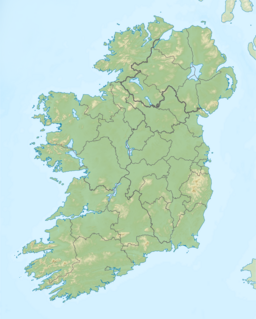Lough Gur
| Lough Gur | |
|---|---|
| Loch Goir (Irish) | |
 | |
| Location | County Limerick |
| Coordinates | 52°30′58.97″N 8°31′59.80″W / 52.5163806°N 8.5332778°W |
| Basin countries | Ireland |
| Surface area | 0.78 km2 (0.30 sq mi) |
| Average depth | 1.5 m (4 ft 11 in) |
| Max. depth | 3.8 m (12 ft) |
| Water volume | 1.2 hm3 (970 acre⋅ft) |
| Residence time | 0.21 years[1] |
Lough Gur (
3000 BC and there are numerous megalithic remains there.[3]
Irish national monuments.[3]
It is here that the 14th-century lord of Munster and poet Gearóid Iarla, votary of the Goddess Áine, is said to sleep in a cave and emerge at the time of Ireland's need to gallop around the lake on his great silver-shod white horse.[4]
A visitors' centre is open beside Lough Gur, along with a car park and picnic area. A gradual shoreline is present at the visitor area, with a shallow section of lake reaching up to the maintained lawn. As a result, the area is often used for
water sports, though motorised craft are banned on the lake.[3]
There is a
Norman castle, Black Castle,[3] which is reached by a hillside walk along the east side of the lake. This is one of the keeps used during the Desmond Rebellions and is probably the place where the Earl of Desmond secured his authority in 1573 after casting off his English apparel and donning Irish garments on his return to Munster from London.[citation needed
]
Lough Gur is a famous location for finding Irish Elk skeletons. The National Museum of Ireland - Natural History has specimens from Lough Gur[5] as does Leeds Museums and Galleries in the UK.[6]


See also
- Early history of Ireland
- List of loughs in Ireland
References
- ^
De Eyto E, Irvine K (2007). "Assessing the status of shallow lakes using an additive model of biomass size spectra" (PDF). Aquatic Conservation: Marine and Freshwater Ecosystems. 17 (7): 724–736. hdl:10793/133.
- Department of Culture, Heritage and the Gaeltacht and Dublin City University. Retrieved 14 March 2020.
- ^ a b c d e f g Illustrated Guide to Lough Gur, O'Kelly, M. J. and O'Kelly, C. 1981. Published by Houston, Cork.
- ISBN 9781847175755– via Google Books.
- ^ Chritz, Kendra (2009). "New insights on Giant Deer (Megaloceros giganteus) paleobiology inferred from stable isotope and cementum analysis". Journal of Vertebrate Paleontology. 29:78A-78A.
- ^ Steadman, M., 2019 "A History of the Scientific Collections of the Leeds Philosophical and Literary Society's Museum in the Nineteenth Century: Acquiring, Interpreting & Presenting the Natural World in the English Industrial City" University of Leeds, UK, unpublished PhD thesis https://etheses.whiterose.ac.uk/25449/1/Steadman%20Thesis%2014_06_2019.pdf
External links
![]() Media related to Lough Gur at Wikimedia Commons
Media related to Lough Gur at Wikimedia Commons
- Lough Gur - official visitor centre site at Shannon Heritage
- Lough Gur Neolithic Settlement and Stone Age Centre
- Lough Gur Development site.
- Google Earth Community KMZ file indicating the location of several important Lough Gur sites.

